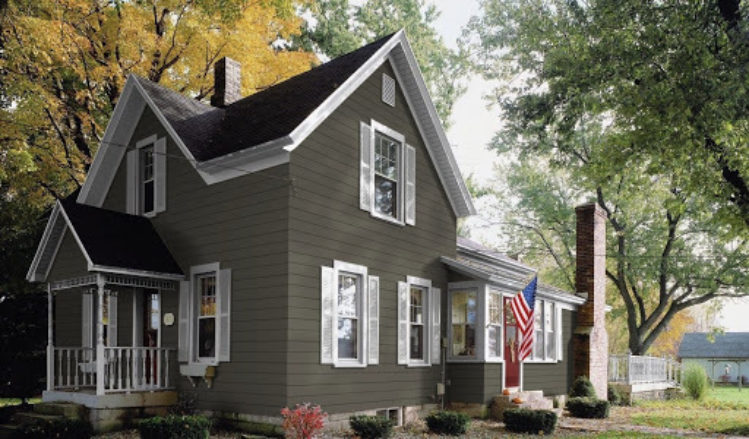
There’s no debate: wood lap siding is an iconic look seen from small homes in the suburbs to sprawling lodges in the rural mountains. As popular as wood lap siding may be, however, there are some significant disadvantages to this traditional exterior choice.
Before you invest in natural wood lap siding, be sure to consider the inherent drawbacks you’re getting with wood. After all, there’s an alternative to wood lap siding that looks just as good but performs much better. Take a look!
1. Color Fading
Color fading is one of the most common problems that homeowners can expect with wood lap siding. Color fading occurs naturally over time with consistent sun exposure. It may not seem like a big deal, but it can become an incredible eyesore with wood lap siding. Most homes experience different amounts of sun exposure throughout the day, depending on the structure’s orientation and inconsistent shading from nearby trees and tall buildings. This irregular exposure to sunlight can cause different parts of the wood lap siding to fade faster than others, leaving variations in the pigmentation, which can cause parts of the exterior to look splotchy, bare, and faded compared to other parts.

2. Chipping, Peeling, and Cracking
Sun exposure can pose another challenge for wood lap siding: chipping, peeling, and cracking. While more common in dry, arid regions, it can also occur during warmer seasons in temperate areas. Chipping, peeling and cracking typically result from prolonged exposure to UV rays, which can dry out the wood lap siding.
3. Moisture Damage
Though water damage falls on the other end of the spectrum due to excess moisture, it can be just as common of a problem as sun damage. When moisture lingers after heavy rains or snowy winter, it quickly starts to take a toll on wood lap siding. Moisture damage typically shows up as warped and/or rotten panels, which can compromise both the aesthetic quality and the siding’s structural capacity.
4. Mold and Mildew Buildup
Excess moisture can also lead to mold and mildew buildup, particularly on the north-facing side of a building, which usually endures less sun exposure. Sunny spots of exterior wood lap siding can also be a breeding ground for mold and mildew without regular cleaning and ventilation.

5. Insect Damage
Another disadvantage of wood lap siding is that it is naturally susceptible to insect damage. Termites, ants, wasps, and other insects can cause a significant amount of damage to natural wood lap siding, eventually destroying the integrity of the exterior panels — possibly at the risk of the insects gaining access to areas found deeper within the home. In addition to insect damage, it’s not uncommon for wood lap siding to be riddled with holes in areas where woodpeckers are present, too.
6. High Flammability
Wood is highly flammable, which is why having natural wood lap siding on a home can increase the risk of a fire becoming uncontrollable. There are fire-resistant coatings that can help decrease natural wood siding’ flammability, but it still remains a highly flammable material compared to alternative siding options. If a fire breaks out, it can spread in a matter of minutes, which is why every second counts. Utilizing less flammable building materials can stall the spread of a fire and give homeowners a few extra needed moments to react to the situation — which can sometimes be the difference between life and death.
7. High-Maintenance
Since natural wood lap siding is a relatively vulnerable building material, it can be considered a high-maintenance area of the home. Whether there’s damage from water, insects, or sun exposure, property owners can expect to commit a lot of time and money in keeping wood lap siding looking and performing its best. Sanding, repainting, restaining, and caulking are just a few of the chores that will need to be done on a regular basis to maintain the exterior. For those who like a predictable chore list, this usually isn’t a problem, but for homeowners who don’t have the time, money, or interest in performing regular maintenance, natural wood lap siding may not be the best exterior choice for the home.

Ditch the Disadvantages and Get Strong Lap Siding with a Wood-Look
One way to ditch all these disadvantages of wood lap siding is to opt for an alternative building material that provides enhanced durability. The good news is that it doesn’t always mean that homeowners have to give up the iconic look of wood lap siding. In fact, Allura offers fiber cement siding panels that look just like real wood.
Lap siding made from fiber cement can give homeowners added peace of mind, as this sturdy material can stand up to prolonged sun exposure, moisture, and insects without any issue. Plus, fiber cement isn’t highly flammable, like natural wood.
Allura’s fiber cement lap siding is a great way to get a more durable exterior that looks super attractive! Contact the siding experts at Allura today for more information on lap siding.




